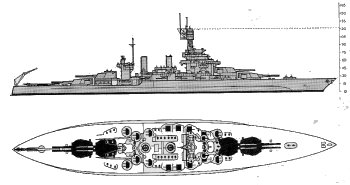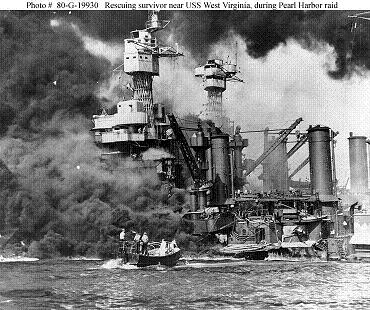![]() The Pacific War Online Encyclopedia
The Pacific War Online Encyclopedia
|
| Table of Contents |
 ONI 222 |
|
Tonnage |
32,600 tons standard displacement |
|
Dimensions |
624' by 97'4" by 31'4" 190.2m by 29.67m by 9.55m |
|
Maximum speed |
21 knots |
|
Complement |
1080 |
| 1 catapult 3 seaplanes |
|
|
Armament |
4x2 16"/45
Mark 1
guns 12x1 5"/51 guns 8x1 5"/25 AA guns |
| About 8696 tons or 27% of displacement: 13.5" (343mm) belt tapering to 8" (203mm) below the waterline 1.75" STS + 1.75" NS = 3.0" (44mm STS + 44mm NS = 76mm) armor deck 4.5" STS + 1.75" MS = 5.5" (114mm STS + 44mm MS = 158mm) over steering spaces 1" STS + 0.5" MS =1.3" (25mm STS + 13mm MS = 33mm) splinter deck 13" (330mm) bulkheads tapering to 8" (203mm) below waterline 18"/7"STS/10"/9" (457mm/178mm STS/254mm/229mm) turret front/roof/side/rear 13" (330mm) barbettes Splinter protection for 5"/25 guns 16" (406mm) conning tower 17'3" (5.3m) underwater protection consisting an outer void compartment, two liquid compartments, and an inner void compartment with a holding bulkhead. This was designed to withstand a 400 lb (181 kg) explosion. |
|
| Machinery |
4-shaft turbo-electric drive
(28,900 shp) 8 Babcock & Wilcox boilers |
|
Bunkerage |
1900 tons fuel oil |
|
Range |
8000 nautical miles (14,800 km) at 10 knots |
| Modifications |
Maryland was armed with 4x4 1.1"/75 AA guns by 1941-12. In 1942 she was refit with 16 20mm Oerlikon AA guns and SC and FC radar. By 1943-2 her light antiaircraft was 6x4 1.1" and 48 20mm guns. In 1943-11 she landed two 5"/25 guns, 8 20mm guns, and all her 1.1" guns in return for 6x4, 4x2 40mm Bofors AA guns. In early 1944 the twin 40mm were replaced with quadruples and a quad 20mm gun was added. Following a kamikaze hit on 1944-11-29, she received a final upgrade, replacing her 5"/51 guns with 8x2 5"/38 dual-purpose guns. Colorado was under refit in
1941-12 and received improved torpedo
bulges, 4x4 1.1" guns, 14x1 20mm guns, and SC and FC radar. By 1942-11
she had 22 20mm guns. In 1943-11 this was increased to 42 20mm guns. In
early 1944 the twin 40mm were replaced with quadruples and a quad
20mm gun was added. West
Virginia was extensively rebuilt following her salvage in 1944.
This included rebulging and the addition of 3" (76mm) of horizontal
armor over the magazines and 2" (51mm) over the machinery spaces. The
secondary armament was 8x2 5"/38 guns and light antiaircraft was 10x4
40mm guns and 40 20mm guns. SC and FC radar were fitted. The 20mm
armament was eventually increased to 1x2, 1x4, and 58x1 20mm guns. |
The Colorados
were the fifth and last of the "standard battleship" classes. They were the most modern battleships in the
United States
Fleet at the start of the Pacific
War, save for the North
Carolina,
which was still shaking down in the Atlantic. Though Colorado had the lowest hull number
and was thus the class namesake, Maryland
was the first ship of the class actually laid down and completed, in
1921, just before the naval disarmament
treaties imposed a "battleship holiday." Colorado and West Virginia were completed in
return for Japanese retention of Mutsu,
while a fourth sister ship, Washington,
was canceled when 76% complete and the hull was expended as a target
ship in 1924.
The Colorados closely resembled the
previous Tennessee class, except for
their 16" (406mm) main armament. They had
excellent subdivision, due to their use of turbo-electric drive, and
proved
reliable in service.
Ironically, because they were the most modern ships in the fleet, they
were never extensively modernized between the wars. This left them more vulnerable to air attack than the older ships, because they never received additional deck armor. Furthermore, because
of the pressing need for battleships following the Pearl Harbor
catastrophe, only West Virginia
had its horizontal protection strengthened during the war.

West Virginia was sunk by at least five torpedo hits at Pearl Harbor, while Maryland took two bomb hits and was jammed against her moorings when Oklahoma capsized alongside her. Maryland was repaired within a few weeks, but West Virginia took two years to raise and repair, though this also provided the opportunity for extensive modernization. Colorado herself was undergoing refit at Bremerton and avoided the disaster.
The modernization of West Virginia included an all-dual-purpose secondary battery and modern fire control. A measure of the improvement in fire control is that West Virginia straddled with her first salvo at the Battle of Surigao Strait.
| Bremerton | Completed refit on 1942-3-31 | |
| Pearl Harbor | Returned to service 1942-2-26 |
|
| Pearl
Harbor |
Returned to service 1944-7 |
 |
 |
 |  |
 |
References
Friedman (1985)
Whitley (1998)
The Pacific War Online Encyclopedia © 2007-2009, 2012-2014 by Kent G. Budge. Index